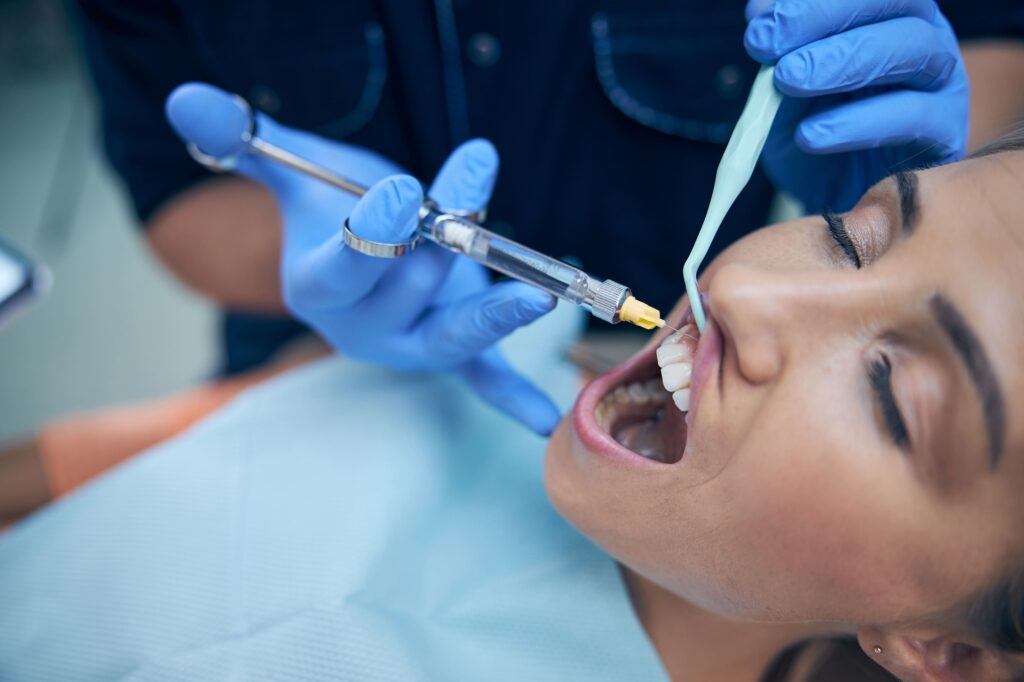
The prospect of dental procedures often triggers fear and discomfort for many patients. Understanding the various forms of dental anesthesia and their roles in creating a relaxed environment is key to dispelling such fears. We believe that your dental health should never be hindered by fears related to dentistry. This blog aims to give you an understanding of the most common of anesthesia techniques employed in dental procedures, how they function, and their importance in facilitating an anxiety-free dental experience.
Nitrous Oxide
Nitrous oxide, colloquially known as “laughing gas”, is often used for painless, non-invasive dental procedures. Inhaled it via a nasal mask, this technique is unique due to its dual benefit: it reduces pain and induces a happy feeling, mitigating any lingering anxiety.
As it is administered, you might feel a gentle warmth or a slight heaviness in your limbs. This immediate effect sedates patients while keeping them alert, facilitating effective dialogue with the dental staff throughout the procedure.
Dentists employ nitrous oxide is due to its mild and controllable properties. The degree of sedation can be easily adjusted, making it a flexible choice for various dental procedures and patient demographics – from basic cleanings for anxious kids to extractions for adults.
When it comes to recovery, nitrous oxide is swiftly eliminated from the body. The influence wanes within minutes of discontinuing the gas and breathing in pure oxygen. This expedited recovery allows most individuals to return home safely post-procedure, engaging in their usual activities without any lingering sedative effects.
However, nitrous oxide may not be suitable for everyone. Certain situations like pregnancy, respiratory complications, or specific medication routines might necessitate alternate methods. Therefore, an extensive conversation with your dentist about your medical background and comfort level is crucial in determining the most appropriate anesthesia for your dental healthcare needs.
IV Anesthesia
IV dental sedation is used for complex or long-lasting dental treatments, and involves the administration of tranquilizing substances into your circulatory system through an IV line, usually. This practice lets dental professionals precisely regulate sedation degrees, securing your comfort whilst maintaining your wakefulness but a relaxed state, not full sleep.
Under IV sedation, you may experience a dreamlike feeling or feel as if you passed the entire process asleep. Frequently, patients report partial or complete memory loss of the procedure, an advantageous outcome for those with significant dental fears.
Primarily, this technique is used for major dental surgeries, including wisdom teeth removal or the installation of dental implants. It plays an integral role for patients who might otherwise overlook crucial dental care due to anxiety or worry. Nevertheless, it’s worth noting this sedation grade induces a deep relaxation, requiring the need for a friend or family member to chauffeur you home after the procedure.
IV dental sedation, like all dental anesthetics, is designed to ensure your comfort and mitigate anxiety during your dental appointment. Having a candid conversation with your dental care team fosters a cooperative atmosphere in choosing the anesthesia technique best suited for your specific needs and fears.
Oral Conscious Sedation
If you have a fear of needles, oral conscious sedation could be a suitable alternative for your dental procedures. This technique uses prescription medication, usually in the form of a pill, taken prior to your appointment. Its unique characteristic lies in its ability to evoke a calm state, while concurrently preserving your ability to heed your dentist’s instructions throughout the procedure.
Despite its reputation for inducing sleepiness, you will retain the capability to converse and engage during your dental appointment. Known as ‘conscious sedation’, this method aims to considerably reduce physical discomfort and anxiety levels, whilst maintaining your cooperation with your dentist. It is this fine balance that gives oral conscious sedation its attractiveness to those who dread needles or suffer from increased dental anxiety.
It’s important to note that oral sedation’s calming effects do require a longer recovery time compared to other sedation methods. Generally, recovery involves several hours, during which you may feel slightly drowsy or disoriented. Due to these after effects, it is strongly advised to arrange for transportation home after the procedure.
However, this minor inconvenience is usually offset by the serene, stress-free dental experience offered by oral conscious sedation. It should be remembered that, like all sedation techniques, a comprehensive consultation regarding your medical history and comfort levels with your dentist is necessary. This in-depth discussion ensures the selected method is bespoke to your specific circumstances, enabling a relaxed, stress-free dental appointment.
The dental professionals at Real Life Dental continually prioritize patient safety and comfort in their practice. Regardless of whether the procedure is minor or more complex, being informed about the various sedation options, like oral conscious sedation, can transform your dental care experience, providing you with the confidence to face each dental appointment head-on.
Recovery and After-care
Recovery times after dental procedures vary according to the type of anesthesia administered. Nitrous oxide, for example, wears off as soon as the mask is removed, allowing you to resume normal activities almost immediately. On the other hand, deeper sedation techniques like IV and oral conscious sedation could necessitate several hours, or even a full day, for the effects to completely subside. Local anesthesia typically subsides within a few hours post-procedure.
Adherence to your dentist’s post-anesthesia advice is crucial. Common directives may include engaging in light activities for a few days, maintaining hydration, and getting sufficient rest. The goal is to ensure your body sufficiently recovers from the anesthesia, fostering a smooth and successful dental procedure. Be sure to monitor your physical condition and notify your dentist of any abnormalities or prolonged discomfort following the procedure. Remember, your dental care team at Real Life Dental is devoted to supporting you throughout every stage, including recovery.
